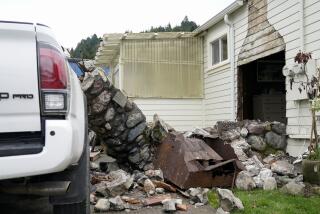WATCHING THE WEATHER : Doppler Radar Stations Accurately Track A Storm’s Full Fury
Six state- of- the- art Doppler weather radar stations have gone into operation covering California from Eureka to Ventura County, substantially increasing the accuracy of forecasts. They have given forecasters from the National Weather Service a richly detailed picture of where and how heavily rain is falling. *
THE DOPPLER EFFECT Named after Christian Doppler, a 19th-century Austrian physicist, the Doppler effect detects and measures movement based on a change in the observed frequency of a sound or electromagnetic wave. In the case of Doppler weather radar, microwaves bouncing off a moving object are reflected back to the observer at changing frequencies. Because of its shorter wavelength, Doppler radar can detect smaller particles with greater accuracy than conventional radar. A familiar example of the Doppler effect is the sound of a train’s horn that seems to have a higher pitch as it approaches. As it moves away, the pitch sounds lower. *
Pitch of approaching train seems higher. Pitch of train moving away seems lower.
SEEING STORMS Forecasters can watch the atmosphere develop, analyzing in detail the radar signals reflected by storms. Unlike conventional radar systems, which can only hint at a storm’s intensity, the full-color displays can tell: * The power of a thunderstorm
* Total moisture content of a cloud or storm
* How much precipitation is falling
* The direction of a storm
* Whether a storm is producing rain, hail or snow
* Doppler radar sees with amazing accuracy up to 125 miles, although it can reach as far as 250 miles. * Forecasters can track winds associated with a storm that they were unable to see with conventional radar.
* The beam scans the atmosphere as high as 40,000 feet. Most storm bases are found at about 3000 feet and top out at 35,000 to 45,000 feet.
DOPPLER SITES
Medford, Ore.: Start- up: Nov. 1995 Operational: Eureka Beale AFB: Start- up: Jan., 1996 Operational: Reno, Nev. Operational: Sacramento Operational: Monterey Hanford: Start- up: April, 1995 Las Vegas, Nev.: Start- up: March, 1995 Edwards AFB: Start- up: March, 1995 Operational: Vandenberg AFB Operational: Los Angeles March AFB: Start- up: Jan., 1996 Yuma, Ariz: Start- up: Feb., 1996 San Diego: Start- up: March, 1996 Source: National Weather Service.
Researched NONA YATES / Los Angeles Times
More to Read
Sign up for Essential California
The most important California stories and recommendations in your inbox every morning.
You may occasionally receive promotional content from the Los Angeles Times.










